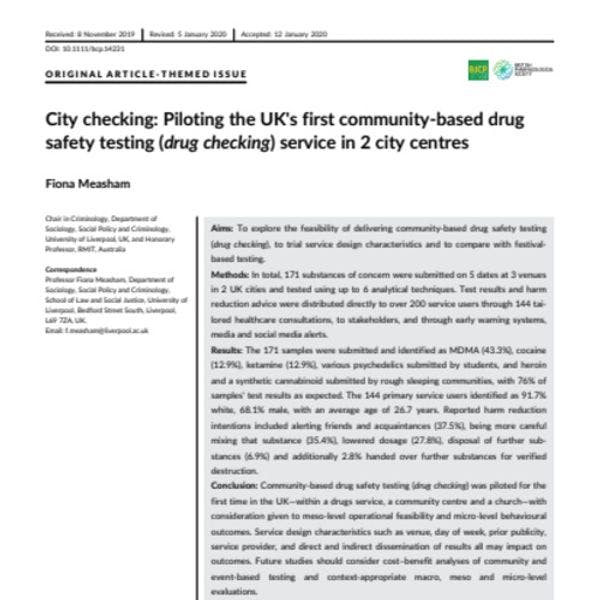Verificación en la ciudad: Ensayando el primer ejemplo de servicio de base comunitaria sobre seguridad de drogas (verificación de sustancias) en 2 centros en la ciudad
Measham analiza el impacto de verificación de drogas de base comunitaria y los resultados conductuales relacionados. Más información, en inglés, está disponible abajo.
By Fiona Measham
Aims: To explore the feasibility of delivering community-based drug safety testing(drug checking), to trial service design characteristics and to compare with festival-based testing.
Methods: In total, 171 substances of concern were submitted on 5 dates at 3 venuesin 2 UK cities and tested using up to 6 analytical techniques. Test results and harmreduction advice were distributed directly to over 200 service users through 144 tai-lored healthcare consultations, to stakeholders, and through early warning systems,media and social media alerts.
Results: The 171 samples were submitted and identified as MDMA (43.3%), cocaine(12.9%), ketamine (12.9%), various psychedelics submitted by students, and heroinand a synthetic cannabinoid submitted by rough sleeping communities, with 76% ofsamples' test results as expected. The 144 primary service users identified as 91.7%white, 68.1% male, with an average age of 26.7 years. Reported harm reductionintentions included alerting friends and acquaintances (37.5%), being more carefulmixing that substance (35.4%), lowered dosage (27.8%), disposal of further sub-stances (6.9%) and additionally 2.8% handed over further substances for verifieddestruction.
Conclusion: Community-based drug safety testing (drug checking) was piloted for thefirst time in the UK—within a drugs service, a community centre and a church—withconsideration given to meso-level operational feasibility and micro-level behaviouraloutcomes. Service design characteristics such as venue, day of week, prior publicity,service provider, and direct and indirect dissemination of results all may impact onoutcomes. Future studies should consider cost–benefit analyses of community andevent-based testing and context-appropriate macro, meso and micro-levelevaluations.
